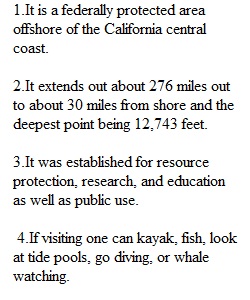


Q OCEN 101 Spring 2021 Monterey Bay Virtual Field Trip* Due Sunday at 11:59pm You may use this document to respond to the questions for the lab. Alternatively, you may print out the lab at home and answer the questions there and turn in via photos/scan. Whatever works for you! If you type into the document, please try make your answers un-bold or a different but readable color. Please make sure to read all of the directions carefully! I don’t have them there to look pretty – but to help guide you! Please answer questions in complete sentences. In this Virtual Field Trip, we will visit the Monterey Bay Marine Sanctuary of California, and review the physical characteristics and marine life found in this protected area. We will also investigate some of the environmental issues of the area, and how we might mitigate (solve) these issues. Note: Some of the live cams are only on 7am-7pm Pacific time. This may be a difficult middle of the night assignment to do. *This is a modified version of a field trip adapted from Jennifer Nelson, Indiana University, Purdue University. The Monterey Bay is a marine sanctuary, as described on this page: http://montereybay.noaa.gov/intro/welcome.html . Review this website and its links, then answer these questions: 1. What is a marine sanctuary? 2. What are the characteristics of the Monterey Bay Marine Sanctuary? (size, amount of shoreline, depth)3. Why was the Monterey Bay Marine Sanctuary established? What is its purpose?4. What are some things that a person can do in the sanctuary, if they were to visit in person? 5. Provide a short summary of research activities in the sanctuary by describing at least three areas of research in the sanctuary. What are researchers studying here, and why?
View Related Questions